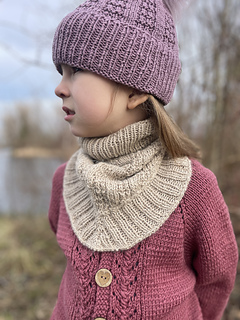patterns >  Appelbanne Design
Appelbanne Design
> Ris Cowl







































Ris Cowl
The name comes from Norwegian. Ris means rice. The structural pattern reminds me a lot
Grains of rice, which made the naming very easy for me. Because I love the Scandinavian languages,
styles and cultures. And that’s how I always associate the names of my designs with it.
The Ris Cowl is knitted seamlessly from top to bottom, first in the round and then in rows. The bib is formed by decreasing and to round it off, the entire cowl is knitted with a wide cuff at the end.
The bib has four sizes:
XS (Baby), S (Kids), M (Adult), L (Maxi)
Gauge:
18-20 sts = 10 cm in pattern (washed)
Needle size:
4 mm - 5 mm (depending on the needle size
required mesh sample results. They are suitable
Circular knitting needles with a length of 60 cm
Material:
Wool in DK (e.g. 50 g = yardage approx. 70 - 120 m)
Yarn suggestions:
Svarta Faret Soft Lama, highland wool from Das Oderdeichschaf, Lana Grossa Landlust Merino Alpaca 100, Zitron Tasmanian Tweed, BC Garn Loch Lomond
Consumption max.: (150) 200 (300) 450 m
Techniques:
right and left stitches
Increase on the right and left
Material: stitch marker, wool needle, scissors, tape measure
German:
Der Name stammt aus dem Norwegischen. Ris bedeutet Reis. Das Strukturmuster erinnert mich sehr an
Reiskörner, was mir die Namensgebung sehr vereinfacht hat. Denn ich liebe die skandinavischen Sprachen,
Stile und Kulturen. Und so verbinde ich damit auch immer die Namen meiner Designs.
Der Ris Cowl wird nahtlos von oben nach unten, zuerst in Runden und dann in Reihen gestrickt. Der Latz wird durch Abnahmen geformt und zur Abrundung wird der gesamte Cowl am Ende mit einem breiten Bündchen umstrickt.
Der Latz hat vier Größen:
XS (Baby), S (Kids), M (Adult), L (Maxi)
Maschenprobe:
18-20 M = 10 cm im Muster (gewaschen)
Nadelstärke:
4 mm - 5 mm (Je nachdem welche Nadelstärke die
erforderliche Maschenprobe ergibt. Es eignen sich
Rundstricknadeln mit 60 cm Länge
Material:
Wolle in DK (z. B. 50 g = Lauflänge ca. 70 - 120 m)
Garnvorschläge:
Svarta Faret Soft Lama, Hochlandwolle von Das Oderdeichschaf, Lana Grossa Landlust Merino Alpaca 100, Zitron Tasmanian Tweed, BC Garn Loch Lomond
Verbrauch max.: (150) 200 (300) 450 m
Techniken:
rechte und linke Maschen
Zunahme rechts und links
Material: Maschenmarkierer, Wollnadel, Schere, Maßband
Herstellerangaben gemäß GPSR: Inga Mallwitz, Kirchwerderstr. 14, 23556 Lübeck, Germany, info@appelbannedesign.de
3961 projects
stashed
2828 times
401 projects
stashed
311 times
461 projects
stashed
233 times
265 projects
stashed
175 times
- First published: January 2024
- Page created: December 31, 2023
- Last updated: December 13, 2024 …
- visits in the last 24 hours
- visitors right now




